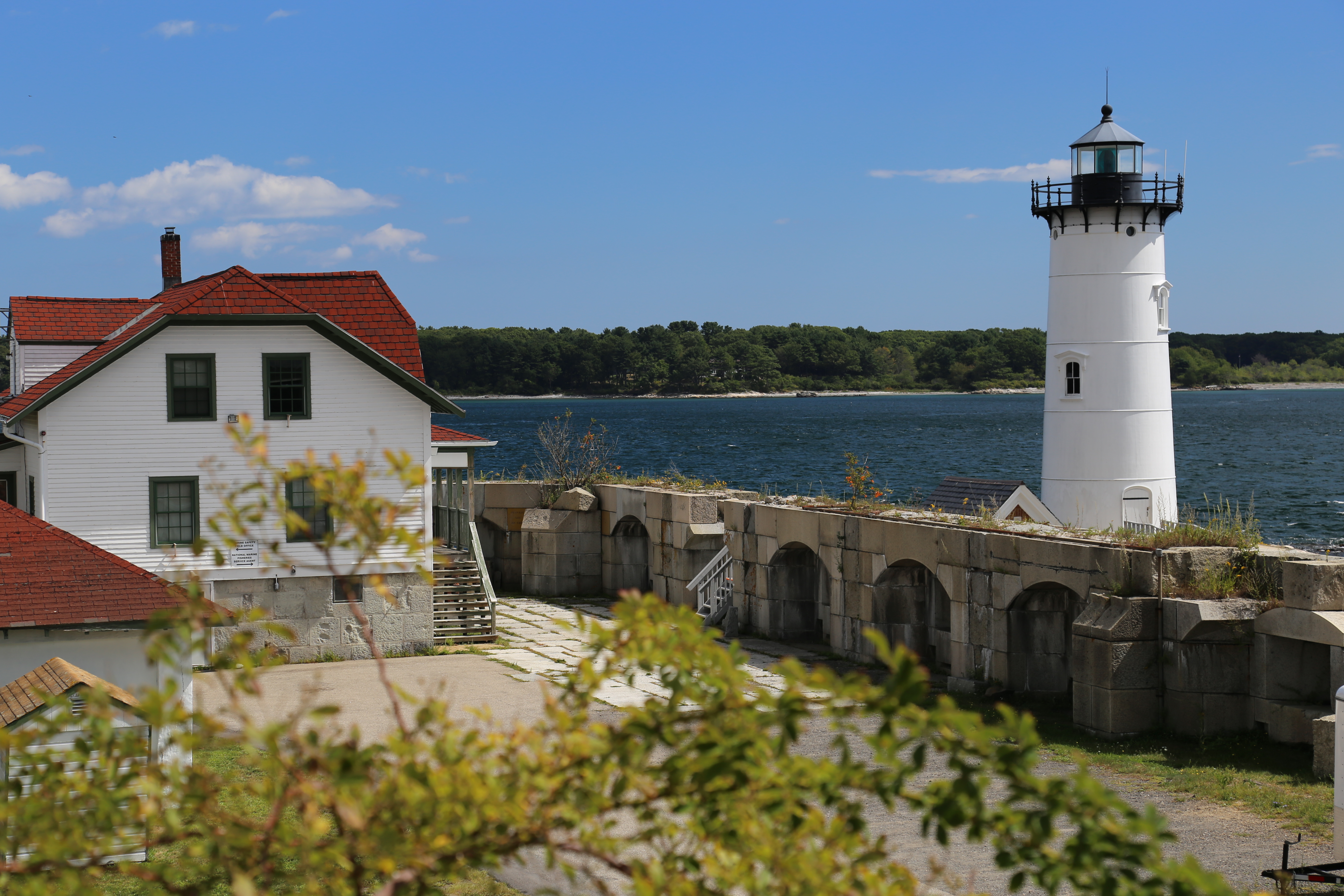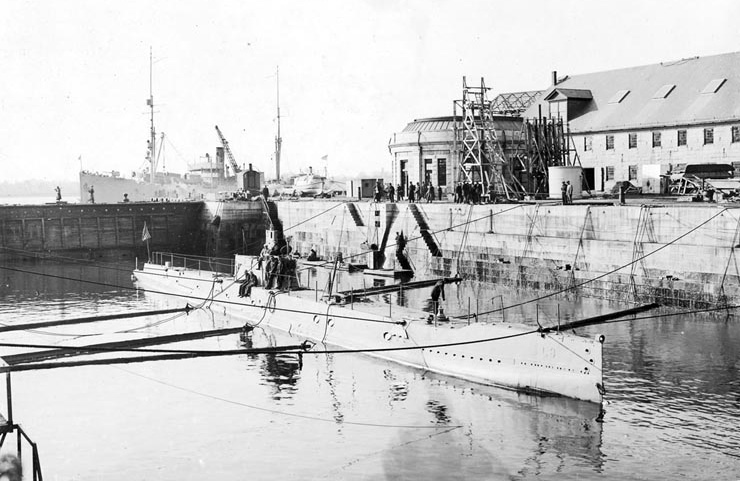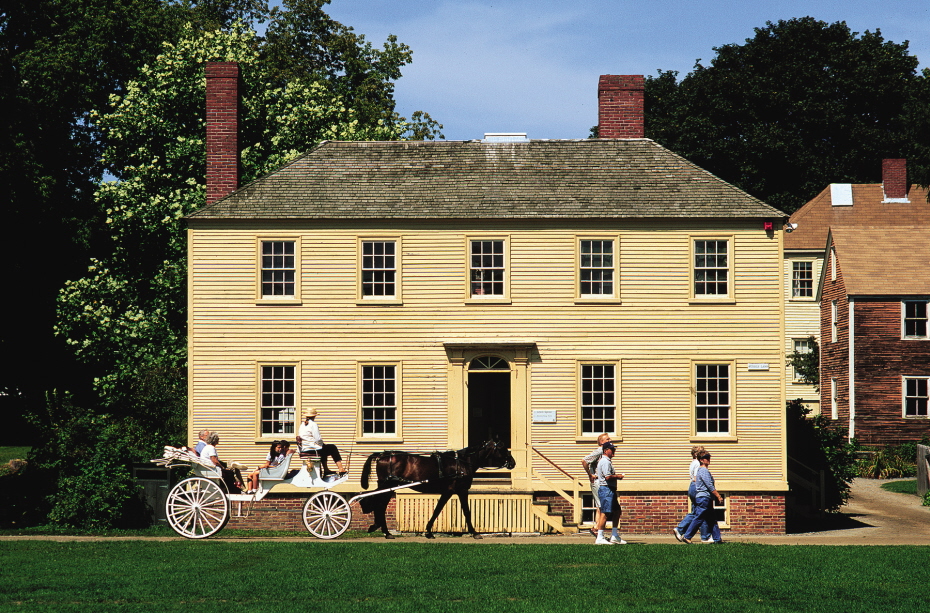|
Fort Constitution
Fort William and Mary was a colonial-era fortification in Great Britain's worldwide system of defenses, defended by soldiers of the Province of New Hampshire who reported directly to the royal governor. The fort, originally known as "The Castle," was situated on the island of New Castle, New Hampshire, at the mouth of the Piscataqua River estuary. It was renamed Fort William and Mary circa 1692, after the accession of the monarchs William III and Mary II to the British throne.Roberts, pp. 498–499 It was captured by Patriot forces, recaptured, and later abandoned by the British in the American Revolutionary War (1775–1783). The fort was renamed Fort Constitution in 1808 following rebuilding, in light of increasing hostilities with the British again, especially from its Royal Navy, resulting in the subsequent War of 1812. The fort was further rebuilt and expanded through 1899, following the Spanish-American War. It served actively through the first half of the 20th century t ... [...More Info...] [...Related Items...] OR: [Wikipedia] [Google] [Baidu] |
New Castle, New Hampshire
New Castle is a town in Rockingham County, New Hampshire, United States. The population was 1,000 at the 2020 census. It is the easternmost town in New Hampshire and the smallest by area, and it is the only town in the state located entirely on islands. It is home to Fort Constitution Historic Site, Fort Stark Historic Site, and the New Castle Common, a recreation area on the Atlantic Ocean. New Castle is also home to a United States Coast Guard station, as well as the historic Wentworth by the Sea hotel. History The main island on which the town sits is the largest of several at the mouth of the Piscataqua River and was originally called "Great Island". Settled in 1623, an earthwork defense was built on Fort Point which would evolve into Fort William and Mary (rebuilt in 1808 as Fort Constitution). Chartered in 1679 as a parish of Portsmouth, it was incorporated on May 30, 1693, and was named "New Castle" after the fort. Until 1719 it included Rye, then called "Sandy Beach ... [...More Info...] [...Related Items...] OR: [Wikipedia] [Google] [Baidu] |
Kittery, Maine
Kittery is a town in York County, Maine, United States, and the oldest incorporated town in Maine. Home to the Portsmouth Naval Shipyard on Seavey's Island, Kittery includes Badger's Island, the seaside district of Kittery Point, and part of the Isles of Shoals. The southernmost town in the state, it is a tourist destination known for its many outlet stores. Kittery is part of the Portland-South Portland-Biddeford metropolitan area. The town's population was 10,070 at the 2020 census. History English settlement around the natural harbor of the Piscataqua River estuary began about 1623. By 1632 the community was protected by Fort William and Mary on today's New Hampshire side of the river; in 1689 defensive works that later became Fort McClary in Kittery Point were added on today's Maine side to the north. Kittery was incorporated in 1647, staking a claim as the "oldest incorporated town in Maine." It was named after the birthplace of a founder, Alexander Shapleigh, ... [...More Info...] [...Related Items...] OR: [Wikipedia] [Google] [Baidu] |
Seavey's Island
Seavey's Island, site of the Portsmouth Naval Shipyard, is located in the Piscataqua River in Kittery, Maine, United States, opposite Portsmouth, New Hampshire. It encompasses . History What is today called Seavey's Island was originally five separate islands conjoined to accommodate the Portsmouth Naval Shipyard. Colonists originally used the rocky islands for collecting wild berries or drying fish on fish flakes. When Secretary of the Navy Benjamin Stoddert decided to create the first federal shipyard in 1800, he authorized the purchase for $5,500 of Fernald's Island (also called Dennett's Island). The largest of the five, Seavey's Island, would be annexed in 1866 and give the grouping its familiar name. Approved by Congress in 1900, a granite drydock was built in the former gut between Fernald's and Seavey's islands. Clark's, Jamaica and another island were attached to Seavey's. Atop a hill on the southern end of Seavey's Island stood an earthwork defense called Fort Su ... [...More Info...] [...Related Items...] OR: [Wikipedia] [Google] [Baidu] |
Portsmouth Naval Shipyard
The Portsmouth Naval Shipyard (PNS), often called the Portsmouth Navy Yard, is a United States Navy shipyard on Seavey's Island in Kittery, Maine, bordering Portsmouth, New Hampshire. The naval yard lies along the southern boundary of Maine on the Piscataqua River. Founded on June 12, 1800, PNS is the U.S. Navy's oldest continuously operating shipyard. Today, most of its work concerns the overhaul, repair, and modernization of submarines. As of November 2021, the shipyard employed more than 6,500 federal employees. As well, some of the work is performed by private corporations (e.g., Delphinius Engineering of Eddystone, Pennsylvania; Oceaneering International of Chesapeake, Virginia; Orbis Sibro of Mount Pleasant, South Carolina; and Q.E.D. Systems Inc. of Virginia Beach, Virginia). History The Portsmouth Naval Shipyard was established on June 12, 1800, during the administration of President John Adams. It sits on a cluster of conjoined islands called Seavey's Island in t ... [...More Info...] [...Related Items...] OR: [Wikipedia] [Google] [Baidu] |
New Hampshire
New Hampshire ( ) is a U.S. state, state in the New England region of the Northeastern United States. It borders Massachusetts to the south, Vermont to the west, Maine and the Gulf of Maine to the east, and the Canadian province of Quebec to the north. Of the List of states and territories of the United States, 50 U.S. states, New Hampshire is the List of U.S. states and territories by area, seventh-smallest by land area and the List of U.S. states and territories by population, tenth-least populous, with a population of 1,377,529 residents as of the 2020 United States census, 2020 census. Concord, New Hampshire, Concord is the List of capitals in the United States, state capital and Manchester, New Hampshire, Manchester is the List of municipalities in New Hampshire, most populous city. New Hampshire's List of U.S. state mottos, motto, "Live Free or Die", reflects its role in the American Revolutionary War; its state nickname, nickname, "The Granite State", refers to its ext ... [...More Info...] [...Related Items...] OR: [Wikipedia] [Google] [Baidu] |
John Sullivan (general)
Major-General John Sullivan (February 17, 1740 – January 23, 1795) was a Continental Army officer, politician and judge who fought in the American Revolutionary War and participated several key events of the conflict, including most notably George Washington's crossing of the Delaware River. He was also a delegate to the Continental Congress, where Sullivan signed the Continental Association. After the war, he served as the third governor of New Hampshire and was appointed as a United States district judge of the United States District Court for the District of New Hampshire. Sullivan, the third son of American settlers, commanded the Sullivan Expedition in 1779, a scorched earth by the Continental Army which destroyed 40 Iroquois villages, leading to the forced displacement of 5,000 Iroquois as refugees to British controlled Fort Niagara and the deaths of several hundred Iroquois during the harsh winter of 1779–1780. As a member of Congress, Sullivan worked closely with ... [...More Info...] [...Related Items...] OR: [Wikipedia] [Google] [Baidu] |
Caretaker Detachment
A military caretaker or caretaker detachment is a group of one or more personnel assigned to maintain for future use a military base, fortification, or other facility that is ungarrisoned but not abandoned. Naval reserve fleets and military aircraft in long-term storage are also maintained by caretakers. Whether the personnel are military or civilian varies by country, branch of service, and time period. British use From 1688 through 1802 the Corps of Invalids was used for garrison and caretaking duties in the British Isles, freeing more capable troops for overseas service. United States use During the American Revolutionary War (as the Invalid Corps) and the American Civil War, the US Army had organizations of wounded or chronically ill men for rear-area service, including caretaker duties. The Civil War organization was the Veteran Reserve Corps, originally the Invalid Corps. The Confederate States Army had a similar organization, the Southern Invalid Corps.Lande, R. Greg ... [...More Info...] [...Related Items...] OR: [Wikipedia] [Google] [Baidu] |
John Langdon (politician)
John Langdon Jr. (June 26, 1741September 18, 1819) was an American politician and Founding Father from New Hampshire. He served as a delegate to the Constitutional Convention, signed the United States Constitution, and was one of the first two United States senators from New Hampshire. As a member of the Continental Congress, Langdon was an early supporter of the Revolutionary War. He later served in the United States Congress for 12 years, including as the first president pro tempore of the Senate, before becoming president and later governor of New Hampshire. He turned down a nomination for U.S. vice presidential candidate in 1812. Ancestry and early life Although information about John Langdon's specific ancestry is not widely available, it is known that his family had roots in England. His father, John Langdon Sr., was a descendant of English settlers who had come to the American colonies. The Langdon family was part of the early wave of European settlers who arrive ... [...More Info...] [...Related Items...] OR: [Wikipedia] [Google] [Baidu] |
Patriot (American Revolution)
Patriots (also known as Revolutionaries, Continentals, Rebels, or Whigs) were colonists in the Thirteen Colonies who opposed the Kingdom of Great Britain's control and governance during the colonial era and supported and helped launch the American Revolution that ultimately established American independence. Patriot politicians led colonial opposition to British policies regarding the American colonies, eventually building support for the adoption of the Declaration of Independence, which was adopted unanimously by the Second Continental Congress on July 4, 1776. After the American Revolutionary War began the year before, in 1775, many patriots assimilated into the Continental Army, which was commanded by George Washington and which ultimately secured victory against the British Army, leading the British to end their involvement in the war and acknowledge the sovereign independence of the colonies, reflected in the Treaty of Paris, which led to the establishment of the Un ... [...More Info...] [...Related Items...] OR: [Wikipedia] [Google] [Baidu] |
Fort William And Mary, 1705
A fortification (also called a fort, fortress, fastness, or stronghold) is a military construction designed for the defense of territories in warfare, and is used to establish rule in a region during peacetime. The term is derived from Latin ("strong") and ("to make"). From very early history to modern times, defensive walls have often been necessary for cities to survive in an ever-changing world of invasion and conquest. Some settlements in the Indus Valley Civilization were the first small cities to be fortified. In ancient Greece, large cyclopean stone walls fitted without mortar had been built in Mycenaean Greece, such as the ancient site of Mycenae. A Greek '' phrourion'' was a fortified collection of buildings used as a military garrison, and is the equivalent of the Roman castellum or fortress. These constructions mainly served the purpose of a watch tower, to guard certain roads, passes, and borders. Though smaller than a real fortress, they acted as a border gu ... [...More Info...] [...Related Items...] OR: [Wikipedia] [Google] [Baidu] |
Shadrach Walton
Shadrach Walton (1658 3 October 1741) was a British colonial administrator and soldier in the Province of New Hampshire. Military and administrative career Walton commanded Fort William and Mary before 1684, and again from 1697 to 1708. He was appointed ensign in 1690, when New Hampshire and Massachusetts were reunited. He was a selectman of Portsmouth town from 1688 to 1692. He served as a judge of the Court of Common Pleas from 1695-1698, and again 1716-1733. He commanded the New Hampshire provincial troops during the siege of Port Royal 1710, and commanded a combined regiment of New Hampshire and Rhode Island troops during the Quebec Expedition 1711. He was appointed by mandamus a member of the provincial council in 1716, on which he served until 1733. Biography In 1682 Walton's property and his father's inn were the victims of a "stone-throwing devil" that harassed them in a series of poltergeist-like events. '' Lithobolia'', a narrative of the case, was published 1698 in ... [...More Info...] [...Related Items...] OR: [Wikipedia] [Google] [Baidu] |
French And Indian Wars
The French and Indian Wars were a series of conflicts that occurred in North America between 1688 and 1763, some of which indirectly were related to the European dynastic wars. The title ''French and Indian War'' in the singular is used in the United States specifically for the warfare of 1754–1763, which composed the North American theatre of the Seven Years' War and the aftermath of which led to the American Revolution. The French and Indian Wars were preceded by the Beaver Wars. In Quebec, the various wars are generally referred to as the Intercolonial Wars. Some conflicts involved Spanish and Dutch forces, but all pitted the Kingdom of Great Britain, British America, its colonies, and their Indigenous peoples of the Americas, Indigenous allies on one side against the Kingdom of France, French colonization of the Americas, its colonies, and its Indigenous allies on the other. A driving cause behind the wars was the desire of each country to take control of the interior terr ... [...More Info...] [...Related Items...] OR: [Wikipedia] [Google] [Baidu] |






